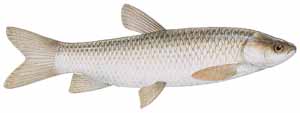Grass Carp (Ctenopharyngodon idella)
- Other Names
- White Amur, Waan Ue
- Description
- Ctenopharyngodon and idella are both Greek words, meaning "comb-like throat-teeth" and "distinct" respectively. The grass carp is one of the largest members of the minnow family. The body is oblong with moderately large scales, while the head has no scales. There are three simple and seven branched rays on the dorsal fin. Grass carp are silvery to olive in color, lacking the golden hue of common carp, and they have no barbels. This species typically reaches sizes of 65 to 80 pounds in its native habitat, but individuals approaching 400 pounds have been reported.
- Life History
- Typically, spawning occurs in the spring when water temperatures reach 59-63°F, and under rising water conditions. Eggs are semi-pelagic and must remain suspended during the 20-40 hour incubation period. Therefore, long river stretches are usually necessary for successful spawning. Once young grass carp reach approximately three inches in length, they become nearly 100% herbivorous. Their feeding habits make them ideal as vegetation control agents, as they are capable of consuming 40% to 300% of their body weight per day in plant material. The species shows a high tolerance for salinity; specimens have been known to survive for several days in water up to three times as salty as sea water.
- Distribution
- Grass carp are native to large rivers in Asia, ranging from the Amur River in China and Siberia south to the West River in China and Thailand. As a food fish, the species has been cultured nearly worldwide. Because of its utility as a biological control for aquatic vegetation, the grass carp has been legally introduced into at least 35 states in the US. In Texas, triploid (sterile) grass carp have been widely introduced in small private ponds and a few public waters. Diploid (non-sterile) populations have been established by escapees from legal experiments in Lake Conroe and illegal stockings. These fish are known to reproduce in the Trinity River-Galveston Bay area.
- Other
- Grass carp are potentially harmful to native resources. Currently, only triploid (sterile) grass carp are legal for use in Texas, and a permit is required to obtain them. An angler who retains a grass carp caught in public water must immediately remove the intestines, except in waters where a valid Triploid Grass Carp Permit is in effect. In those waters, any grass carp caught must be immediately returned to the water unharmed. The herbivorous feeding habits of this species make it very difficult to catch. When landed, grass carp are excellent table fare despite their bones. The rod-and-reel record in Texas stands at 53.5 pounds. A specimen in excess of 69 pounds was landed by a bow fisher.
